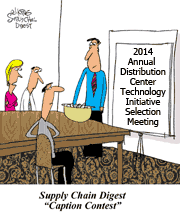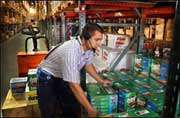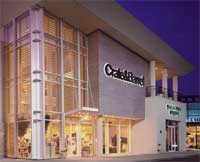 |
February 6, 2014 - Supply Chain Flagship Newsletter |
 |
| THIS WEEK'S SPONSOR: MHI |
 |
|
 |
|
|||||||||||||||||||||||||||||||||||||||||||||||||||||||||||||||||||||||||||||||||||
2014 Supply Chain Predictions Part 2 - the Analysts
|
||||||||||||||||||||||||||||||||||||||||||||||||||||||||||||||||||||||||||||||||||||
| GILMORE SAYS: |
"Expect to see higher rate increases in 2014 if you want to secure capacity from your carriers," Mike Regan predicts. WHAT DO YOU SAY? |
The smart guys and gals at Gartner once again made a set of predictions for global logistics. As usual, they are not really predictions for 2014, but more trends over the next 2-3 years.
Gartner says, for example, that "Through 2018, 75% of companies will struggle to realize their end-to-end supply chain visibility visions due to deployment challenges."
That one surprised me a bit, as it seems to me most large, global companies are making slow but steady progress in visibility, and to have already achieved far deeper levels of visibility than they had five years ago.
Additionally, I learned we have a new three er I mean six-character acronym from Gartner: E2ESCV. That stands for "end-to-end supply chain visibility." We'll see if that one gains much traction. Regardless, Gartner says E2ESVC is about providing "controlled access and transparency to accurate, timely and complete events and data - transactions, content and relevant supply chain information."
Sounds like a good thing, I guess. There are a number of software and logistics service vendors out there promising something of the exact same sort.
The problem, Garter says, is that "There is a discrepancy between what is offered in the market (the "provider view") and what is actually implemented at end-user organizations, providing visibility to their extended value chains (the "user view")."
Add to that the fact that almost all visibility solutions are in effect in functional silos: logistics, manufacturing, procurement, etc., and the challenges of building end-to-end become apparent.
In the end, companies should "have a broad vision, but proceed incrementally with prioritized visibility initiatives," Gartner advices. Yes, that is just the way you have to do it.
On another note, while bullish on concepts like performance-based logistics or "vested outsourcing" between shippers and 3PLs, Gartner does not think these approaches are likely to take off any time soon. It writes that "By 2017, less than 20% of logistics outsourcing engagements will operate using value-based relationship principles."
"While the popularity of value-based logistics outsourcing is on the rise, early attempts to create these unique types of relationships are being met with significant challenges within the buying organizations, in particular within the procurement and legal organizations," Garter says, adding that fewer than 10% of logistics outsourcing relationships are currently based on value-based contracts.
There are just so many barriers to moving away from transaction-based pricing and traditional service level agreements with 3PLs that getting to a more collaborative and value-based approach is just very difficult in practice, Gartner says - even if a shipper recognizes the potential benefits.
Do you agree? More on this soon from SCDigest.
The analysts over at IDC Manufacturing Insights offered two sets of predictions, one for general supply chain and another specific to manufacturing, though the supply chains predictions have a strong manufacturing orientation too.
On the supply chain side, IDC says that in 2014 "The need to be faster will require companies to explore more deeply integrated supply chain planning - and fulfillment functions."
What is interesting to me here is that IDC says the imperative for reducing or eliminating siloed planning efforts isn't so much cost reduction but rather increasing supply chain speed and improving response times.
What's more, IDC says market and competitive realities will force companies to more closely integrate fulfilment execution into the supply chain planning process, something I agree with completely. Most diagrams of supply chain planning processes don't even show execution. That means "throw it over the wall," which just doesn't cut it today. It's about integrated planning and execution.
IDC also says the "demand driven" paradigm will be forced on companies well outside the consumer goods sector, where the idea was first developed, if those firms want to remain competitive.
Key to that will be adoption of "demand sensing" and "demand capture" (POS data) by more industrial types of manufacturers, basically arguing that current channel structures are often barriers for companies to get closer to the customer.
That is by no means a new idea, but manufacturers have struggled to find a way around these barriers without ticking off the channels. Will the need to improve their supply chains at last breakdown these obstacles? We'll see.
In terms of manufacturing specifically, IDC predicts that "Operational resiliency will be the focus of supply chain strategies in 2014 and beyond," adding that "Strategically, in 2013, many manufacturers began the process of determining the 'what' [of operational resiliency]; and we expect manufacturers in 2014 to begin to consider the 'how' and the 'when.'"
In turn, operational resiliency has its underpinnings "in the extreme granularity of data (both upstream and downstream), the increasing need for "accurate" speed in the supply chain, and operational visibility into supply and demand."
I am generally in agreement with this view, but the concept of operational resiliency is still a bit vague, in my view, and the definition probably varies dramatically amongst different companies. Defining the ROI for investments in resiliency is often not easy.
Also on manufacturing, IDC predicts that "On the way toward the factory of the future, 2014 will set the stage for a new manufacturing renaissance."
After a decade or more of relative inattention to manufacturing in many companies and countries, the focus has thankfully returned, IDC says, noting that in the US manufacturing has been a bright spot in the otherwise tepid recovery, and the signs of reshoring strategies continue on.
IDC says that nations "will fiercely compete to develop and attract high-end manufacturing capabilities in industries such as aerospace, industrial machinery and equipment, semiconductors, specialty chemicals, and pharmaceutical."
 It adds that manufacturers will get more global in their manufacturing perspectives, and "standardize production processes across their networks of factories and create better visibility, coordination, and orchestration" on a global basis.
It adds that manufacturers will get more global in their manufacturing perspectives, and "standardize production processes across their networks of factories and create better visibility, coordination, and orchestration" on a global basis.
This is happening for sure. A local rather than global orientation will kill a manufacturer today.
Forrester Research doesn't really cover supply chain anymore, but it's big in ecommerce, and it says that in 2014 there will be an "inevitable rise in shipping charges" for on-line orders, as etailers fight for profitability. We'll have to see on that one too, as competition may not allow it.
Ok, in the limited space left, here are a few predictions for 2014 from yours truly:
• 2014 will be an inflection point in the trajectory of natural gas-based trucks in the US, with a large number of new shippers and carriers joining Lowes, UPS, Saddlecreek Logistics and others in making major commitments to nat gas vehicles. This is where we're headed, with or without government support.
• Growth in developing economies will continue to slow for now, causing multi-national companies some real heartburn relative to strategies that are heavily dependent on emerging market growth.
• 3D printing will make major strides beyond what many observers see, as they do not perceive the direct relevance of "Moore's Law" to this digital technology (me largely ripping off comments I heard from well-known inventor Ray Kurtzweil in 2013).
• Conflict between China and various Asian countries over territorial disputes in the Pacific ocean will expand, perhaps to the point of brinkmanship, and force Western companies and countries to rethink current dependence on China sourcing and hopes for revenue growth there. This situation will be exacerbated by what will be a continued slowdown in China's economy, and maybe even a "hard fall" resulting from its looming debt crisis in 2014-15.
• Cloud-based delivery of supply chain software will continue to gain share this year, on its way to becoming the dominant delivery method by the end of 2015.
We're now done with for 2014 predictions – would love to hear yours.
Any reaction to our 2014 analyst predictions? Have any predictions of your own you can share? Let us know your thoughts at the Feedback button or section below.
| View Web/Printable Version of this Page |
|
|
|
YOUR FEEDBACK
Our friend David Schneider, who has made predictions for us before, was not that wild about our guru predictions published last week, and his email serves as our feedback of the week.
Feedback of the Week: On 2014 Guru Supply Chain Predictions for 2014
The predictions are rather – well – predictable. To the esteemed swami's – I mean no disrespect. These are safe projections for trends that are already in place:
Those are safe predictions. I am, and my clients are more interested in the not so safe predictions. Come step on the wild side with me for a few moments. Alternative fuels: It is not a matter of if, but when, more fleets convert over to Natural Gas. Now that Cummings / Westport have the ISX12 G engine on the market, and Volvo with their D13-LNG engines, the question of motive power for heavy duty over the road trucks has options that work. But the engine is just one part of the puzzle. Volume will help lower the cost of the NG powered tractors, and the issue is not the engines, but the significant cost of the LNG fuel tanks and systems, and the significant weight / bulk of the CNG systems. 2014 will be the year of better understanding of the costs and the opportunities. The fuel network will develop more locations – with more focus on LNG for long haul and CNG for return to base fleets. The real question to ask: "What do you think the price of diesel will be in 2014 - 2019? It is not a one year question, but a 5 year question. If diesel remains above $3.50 at the pump, then the conversion to NG as a fuel will gain velocity. If diesel runs between $3.00 and $3.50, then the conservative players will keep burning distilled fuel, and the only fleets that convert are the ones that do it for non-financial reasons. But if diesel drops below $3.00 for any length of time, watch the bottom drop out of the desire to use NatGas as a motor fuel. Don't think that can happen? Well, just last week I saw some diesel prices along I-81 in the $3.39 region, with one truck stop pulling them in at $3.29. If more of that North Dakota Sweet ends up in the markets, courtesy of the southern sections of the Keystone pipeline, we could see where the price of diesel is low enough to retard NatGas as a major fuel. It's the Weather, Stupid!: Christmas 2013, the multiple storms of Winter 2013-14, and the Atlanta Freeze - these are reminders of how fragile we made all of our transportation / logistics systems in the past decade. Somebody sneezes on a clear summer day on the I-285 Perimeter Loop around Atlanta and stuff stops moving. Make it very cold and through some water into the mix and all hell breaks out. We want to remove the variability out of the performance of the supply chain, it only makes sense from a working capital point of view. But what happens when it really messes with the unrealistic expectations of consumers and angry news anchors? Will some ecommerce players decide to offer discounts for early shopping, perhaps free shipping if you order before December 10? Better yet, will they offer high priced guaranteed delivery for those last minute shoppers that could not make it to the store. Watch this trend: bricks and mortar retailers making solid claims that you should do your last minute shopping with them, adding in wrapping and other value add services to sweeten the deal. How about some of the larger e-tailers getting a little bit more weather savvy - hiring weather services and adjusting the shipping delivery promise based on the customer location, and the projected weather? Finally, here is my special prediction:
David K. Schneider David K Schneider & Company, LLC
|
||
| More on Guru Predictions: | ||
I love how you pull these predictons together each year and how deftly you summartize the thoughts of the different contributors. What makes it a good read is the diveristy of the perspectives and viewpoints - all good. Keep it up.
|
||
| Feedback on SCDigest Weekly Trivia Question: | ||
I liked your trivia question on the two auto ID publications in the 1990s. Automatic ID News and ID Systems are long gone, but it's nice to know they are not forgotten. My memory of Automatic ID News includes editing material from a young guest columnist named Dan Gilmore! Only a couple of us from the staffs of those magazines are still involved in the industries we covered.
John Burnell
|
||
SUPPLY CHAIN TRIVIA ANSWER
Q: What do Gillette, Hewlett-Packard, Johnson & Johnson, Kimberly-Clark, Kraft Foods, Nestlé Purina PetCare, Procter & Gamble, and Unilever have in common, or at least they did about 10 years ago?
A: They were the initial 8 companies picked to ship RFID tagged cases to a Walmart DC in Fort Worth Texas in April 2004 as a proof of concept exercise. 92 more were supposed to begin tagging cases going to a few more DCs starting in January 2005. Some did, some didn't, but the April 2004 testing was actually probably the high point of Walmart's program.
| © SupplyChainDigest™ 2003-2013. All Rights Reserved. SupplyChainDigest PO Box 714 Springboro, Ohio 45066 |
POWERED BY: XDIMENSION
|









